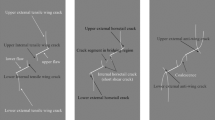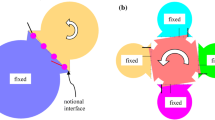Abstract
In order to rationalize the continued safe-flight of the Space Shuttle Orbiter fleet, root cause was urgently sought for the explosive failure of a Space Shuttle Orbiter reaction control system thruster that occurred on the test stand. To confirm the postulated failure scenario, the direction of crack propagation in the fuel chamber wall had to be determined. It was also necessary to determine if any of the failed thruster injector materials had been embrittled over time. Conventional fractography could not provide conclusive answers, but a quantitative 3D analysis of the topographies of the opposing fracture surfaces was able to reconstruct the entire fracture process and thereby confirm root cause. The work shows how a failure event can be replayed through fracture surface topography analysis, FRASTA, and how information on load conditions, relative crack growth rates, and fracture mechanics parameters may be extracted from fracture surfaces.











Similar content being viewed by others
References
Durning, J., Westover, S.: Failure investigation of an intra-manifold explosion in a horizontally-mounted 870 lbf reaction control thruster. NASA report nos: JSC-CN-24119 and JSC-CN-24107, Document ID: 20110013008, 2011. Presented at the 47th American Institute of Aeronautics and Astronautics Joint Propulsion Conference and Exhibit, San Diego, California, 31 July–3 August 2011
Fitzgerald, E.: WSTF Thruster S/N 10 failure: flight rationale and recent NESC high strain rate test summaries. Report to OPOTT, March 23, 2011
Kobayashi, T., Shockey, D.A.: A fractographic investigation of thermal embrittlement in cast duplex stainless steel. Metall. Mater. Trans. A 18A, 1941–1949 (1987)
Kobayashi, T., Shockey, D.A., Jones, R.L.: Deriving SCC initiation times and growth rates from posttest fractographic analysis. J. Corros. Sci. Eng. 47, 528–535 (1991)
Kobayashi, T., Shockey, D.A.: FRASTA: a new way to analyze fracture surfaces, part 1: reconstructing crack histories. Adv. Mater. Process. 140(5), 28–34 (1991)
Kobayashi, T., Shockey, D.A.: Fracture analysis via FRASTA, part 2: determining fracture mechanisms and parameters. Adv. Mater. Process. 140(6), 24–32 (1991)
Kobayashi, T., Shockey, D.A., Ogundele, G., McNabb, D.D., Sidey, D.: Deducing crack history in an aged boiler tube from fracture surface topography. J. Test. Eval. JTEVA 22(4), 309–317 (1994)
Samant, A.V., Lewandowski, J.J.: Effects of test temperature, grain size, and alloy additions on the low-temperature fracture toughness of polycrystalline niobium. Metall. Mater. Trans. A 28A, 2297–2307 (1997)
Padhi, D., Lewandowski, J.J.: Effects of test temperature and grain size on the charpy impact toughness and dynamic toughness (K ID) of polycrystalline niobium. Metall. Mater. Trans. A 34A, 967–978 (2003)
Padhi, D., Lewandowski, J.J.: Resistance curve behavior of polycrystalline niobium failing via cleavage. Mater. Sci. Eng. A366, 56–65 (2004)
Smith, S., Danneman, S., Piascik, R.: High strain rate fracture of reaction control system thruster. NESC technical report (2012)
Allegheny Technologies Incorporated, technical data sheet for ATI C103TM alloy, version 1 (2/26/2012). www.ATImetals.com
Acknowledgments
Assisted by many of their NASA colleagues, Darren Cone of the NASA White Sands Test Facility, Las Cruces, NM, and Erica Worthy, Bud Castner, James Martinez, Joseph Durning, and Shayne Westover of the NASA Johnson Space Center, Houston, TX analyzed the thruster failure and successfully determined root cause and contributing factors. The authors are grateful for their helpful comments on the draft of this manuscript. Bob Piascik, leader of the NESC Materials Technical Discipline Team, saw the potential of FRASTA in this failure analysis investigation and arranged for financial support.
Author information
Authors and Affiliations
Corresponding author
Rights and permissions
About this article
Cite this article
Kobayashi, T., Shockey, D.A. & Jacobs, J.B. Replaying the Fracture Process of a Failed Space Shuttle Orbiter Thruster. J Fail. Anal. and Preven. 12, 583–593 (2012). https://doi.org/10.1007/s11668-012-9622-9
Received:
Published:
Issue Date:
DOI: https://doi.org/10.1007/s11668-012-9622-9




